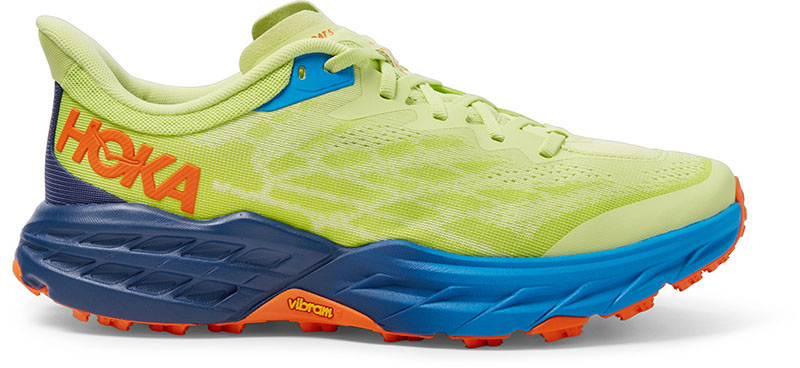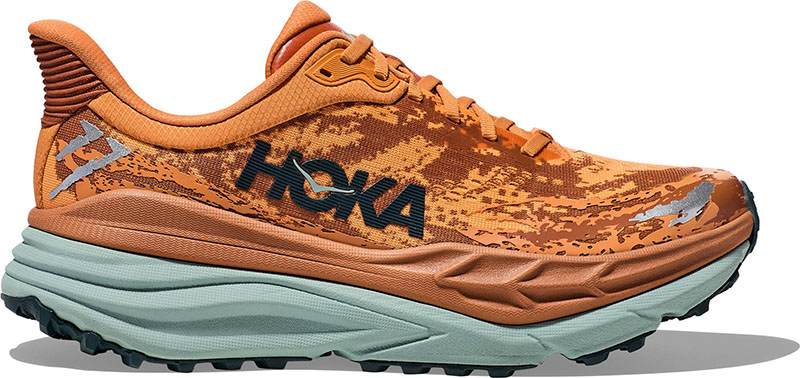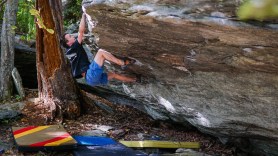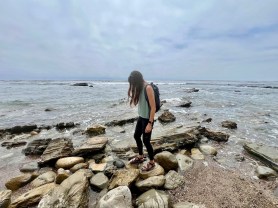

Trail running shoes were made to indulge people who see a hiking trail and start feeling a bit like Forest Gump who all of a sudden “just felt like running.” Unlike the roads that he took on his cross country adventure, trail runners encounter a variety of obstacles, ranging from mud and roots to rocks and sand. So trail running shoes both endure and perform amid those harsh conditions.
Videos by Outdoors
In this article, we list the best trail running shoes available today. For our best overall, we picked the Hoka Speedgoat 5 because it combines qualities for everyone ranging from the beginner trail runner to the expert. But we also listed more specific options if you want a specific type of trail running shoe or cushion design.
Also, for this article, we used research published by REI, which outlines what qualities to look for in a trail running shoe, and we made our selection using user reviews on retail websites as well as independent reviews posted online.
You may also want to check out our picks for best hiking shoes for women, including trail running shoes.
This post contains affiliate links. Outdoors.com may earn a commission when you make a purchase through these links. Thank you for your support.
The Best Trail Running Shoes
- Best Overall: HOKA Speedgoat 5
- Runner Up: Merrell Agility Peak 5
- Best Rugged: Saucony Peregrine 13
- Best Off-Trail: Salomon Speedcross 6
- Best Minimalist: Altra Lone Peak 8
- Most Supportive: HOKA Stinson 7
Best Overall: HOKA Speedgoat 5

Specs
- Material: Recycled Polyester
- Heel to Toe Drop: 4mm
- Weight: 10.3 ounces
For best overall, we picked the Hoka Speedgoat 5 because it’s a great shoe for everyone from the beginner trail runner to the expert.
Most reviewers say the Speedgoat 5 is an excellent design for most technical terrain. Using a Vibram sole, the deep 4-millimeter multidirectional lugs help provide traction in muddy, rocky, and even downhill terrain.
Although the Speedgoat isn’t the “Maximillian” design that Hoka is known for, the moderate cushion still provides enough support to limit the stress on your muscles and joints. With that said, at 10.3 ounces, the design is slightly lighter than average.
While there are a couple of drawbacks to the design, reviewers say the Speedgoat makes up for them in other ways. For instance, it doesn’t have a rock plate, but the soles are thick enough to both cushion and protect.
Runner Up: Merrell Agility Peak 5

Specs
- Material: Engineered mesh
- Drop: 6mm
- Weight: 10.05 ounces
For the runner up, we picked the Merrell Agility Peak 5 because it combines Merrell’s high-quality for trail running shoes with Hoka’s maximum cushion design. So much so that some reviewers actually call it a Speedgoat alternative.
Reviewers say the Agility Peak 5 has a nice balance of cushion and protection, so you can take them from the road to the trail. Plus, with the extra cushion, you can add more miles to a single run.
For protection, the Agility Peak 5 features protective and abrasion-resistant toe caps, but it also has an engineered mesh upper for breathability. As for traction, the sole is equipped Vibram’s Megagrip rubber and lugs.
Best Rugged: Saucony Peregrine 13

Specs
- Material: Mesh
- Drop: 4mm
- Weight: 9 ounces
For the best rugged trail shoe, we picked the Saucony Peregrine 13. Overall, they get high marks for comfort, durability, fit, weight, and more. Plus, at 9 ounces, it’s a lightweight trail running shoe.
With deep lugs, grippy rubber, and a rock plate, users say the Peregrin 13 trail shoe is great for a variety of surfaces, ranging from muddy trails to icy surfaces. Some even say they’re so dependable that they can use them to replace softball cleats.
With the Peregrin 13s, many say that Saucony, which made a name for itself making racing shoes, adapted the comfort and fit of its road running shoes into the trail shoes. The true to size shoes are designed with a medium width, which allows for some room up front in the toe box.
Best Off-Trail: Salomon Speedcross 6

Specs
- Material: Synthetic/textile
- Drop: 10mm
- Weight: 10.5 ounces
For the best off-trail shoes, we picked the Salomon Speedcross 6 because they provide an awesome combination of comfort, protection, and traction.
Although Salomon has more or less perfected its design — at least, for people who love Salomon shoes — the Speedcross 6 is the newest iteration of the shoe design and only has a few updates from older variations.
Reviewers say the improvements include shortening the lugs just a tad and refining the tread pattern so they’re grippier on rocky terrain. Plus, it has a rock plate. Additionally, the company is now using a proprietary rubber for the soles, which is designed to shed mud, and a lighter-weight upper.
As a result, they say the design is now more sensitive than older variants, so you can get a better feel for the ground and therefore, a better footing. Additionally, Salomon is known for “true to size” shoe sizes, meaning you measure your foot and it’ll actually fit.
With a fairly high heel drop, the main criticism of the Speedcross 6 is that it’s not as stable as other shoes, especially if you run downhill.
Best Minimalist: Altra Lone Peak 8

Specs
- Material: Ripstop mesh
- Drop: 0mm
- Weight: 10.7 ounces
For the best minimalist trail shoe, we picked the Altra Lone Peak 8. In the past, many have praised its predecessor, the Altra Lone Peak 7, the new model makes some much-desired improvements. Compared to the Altra Lone Peak 7, the new variant delivers greater comfort, durability, and traction.
With a zero heel to toe drop and a natural foot shape, the Altra Lone Peak 8 is an ideal minimal shoe for trail running. However, there’s enough cushion to support short runs on pavement but they’re also grippy enough for wet rocky surfaces. With that said, the shoe is designed with an engineered mesh upper that allows for breathability and drainage if your foot is submerged in water.
The main drawback, according to the opinion of some, is looks. When compared to the Altra Lone Peak 7, some consider it ugly.
Most Supportive: HOKA Stinson 7

Specs
- Material: Jacquard mesh
- Drop: 5mm
- Weight: 12.9 ounces
Although we often see the Hoka Tecton X 2 listed as the most supportive running shoe, we have to give it to the new and more supportive Hoka Stinson 7. Although they have the same heel to toe drop, the Stinson has a higher heel stack, which gives it maximum cushion and support.
Many reviewers say more support means you’ll have an easier time logging more miles on a single run. While the Stinson 7 is great for technical trails, it also works well for road running, which makes a pair of the Stinson 7s the best running shoes on this list as well as the most supportive.
The downside to the Stinson 7 is that there is a limit to where you can take them. They’re not designed for off-trail running. Still, if you want supportive shoes for that, you should go with the Hoka Tecton X 2, which is a carbon plated shoe.
What to know before buying trail running shoes
Types of Trail Running Shoes
Trail running shoes combine qualities from both running shoes and hiking shoes. They’re supportive and flexible like running shoes and protective like hiking shoes, but how supportive and protective they are depends on the type of trail running shoe.
There are three types:
Light Trail Running Shoe
Out of the three types of trail shoes, the light trail shoe is the closest thing to a road running shoe. The lightweight design is meant for more uniform surfaces. While they have a slightly stretchy mesh upper much like a running shoe, they provide modest protection like a toe guard. They’re also equipped with shallow lugs on the sole for traction on fire roads or gravel paths.
Rugged Trail Shoe
If you like to run on hiking trails, a rugged trail shoe is for you. Rugged trail shoes are designed for well-worn dirt paths and rocky trails similar to what you’ll find in state or national parks. While the trails are rugged, they’re designed to be traveled on.
While they provide cushion and stability while running, rugged trail shoes are designed to provide greater protection from rocks, mud, roots, and other characteristics of technical trails. They feature toe guards, rock plates, thick soles, and deep lugs.
Off-Trail Running Shoe
As the name implies, off-trail running shoes provide support while running through extremely technical terrain. They’re a stable ride for steep mountain climbs, wet surfaces, and rocky terrain in wilderness areas not often traveled by man. If you want something for rugged mountain running adventures, off-trail running shoes are for you.
Out of the three, off-trail running shoes have more in common with hiking shoes than traditional running shoes. An off-trail running shoe features more durable materials than a rugged trail shoe and those materials are often layered for greater protection.
Features of a Trail Running Shoe
Shoe Fit
It doesn’t matter how well a shoe is designed because if it doesn’t fit, your feet will inevitably suffer. Ill-fitting trail shoes can lead to a host of problems, ranging from blisters to calluses to the loss of toenails or worse.
The best way to avoid such problems is to wear appropriately sized shoes. When searching for the right size trail shoe, experts suggest keeping a few things in mind.
First, even if you have an accurate measurement of your feet for both length and width, you should understand that not all shoes fit the same. Some brands will fit larger while others fit smaller or true to size.
Next, your feet will swell and stretch during a run, so you’ll generally want to go a half-size or a full-size up to give your feet room to expand inside the toe box. With that said, the size and shape of your feet can also change with age or activity.
While some shoes are better for high arches or flat feet, experts recommend that you consider getting a supportive insole (and running socks) to support your foot shape because new shoes are equipped with generic non-supportive inserts.
Lastly, specialty running stores like REI or Fleet Feet are equipped with tools to scan and identify the characteristics of your foot, including length, width, and arch. They’ll also help determine whether your foot pronates or supinates. Of course, their assessment is in no way medical advice.
Cushion
Cushion or the lack thereof is an important quality to consider when you buy any kind of running shoe. By absorbing some of the impact of a step, cushioned trail running shoes help relieve the strain on your feet and legs as you run. However, some runners prefer the strain and want to use the natural design of your foot.
Today, there are four basic types of cushion designs. These include barefoot, minimal, moderate, and maximum. With so many options, you might be asking yourself: how much cushion do I need? While each type of cushion has pros and cons, the answer depends on your preference, performance goals, and body.
- Barefoot – While it protects your skin and offers some grip, a barefoot trail running shoe is essentially a glove for your feet. In fact, they’re sometimes called “gloves.” They’re for those who want to fully embrace their biomechanics.
- Minimal – A minimal trail running shoe is a step up from a barefoot running shoe in that it has some padding on the midsole. However, that padding primarily protects the ball of your foot as it strikes the ground. The shoes still let your ankles and legs absorb the impact.
- Moderate – Most traditional trail running shoes use a moderate amount of cushioning. However, moderate is everything between minimal and maximum, which is a fairly wide gap.
- Maximum – Trail runners with maximum cushioning are obvious even to the layman. The soles are thick and sometimes look like a rocker. They’re preferred by ultrarunners and injury-prone runners alike because of how supportive they are.
Heel to Toe Drop
The heel-to-toe drop is the height difference from the shoe’s heel to the toe. It’s important to note that there is some overlap with cushion and heel-to-toe drop. With that said, trail running shoes with more cushion will have a taller heel than those with less cushion.
The heel cushion is designed for a heel strike, meaning the heel of the shoe will absorb some impact to relieve stress on your heel, ankle, Achilles tendon, and calf muscles. The drop will be more than 4 millimeters.
Shoes with little to no heel cushion are designed for a mid-foot strike. These are barefoot (0 millimeters) or minimal cushion shoes (0 to 4 millimeters).
FAQs about Trail Running Shoes
Are trail running shoes waterproof?
No, not all trail running shoes are waterproof. Waterproof trail running shoes will be labeled “waterproof.”
Do I need waterproof shoes for trail running?
It depends. When to wear waterproof trail running shoes and when not to wear them is a little confusing. Before we answer, it’s important to note that waterproof material keeps moisture from getting through to your foot, but it also keeps it from getting out of the shoe. Therefore, waterproof trail running shoes are best when it’s wet outside but not if your feet are going to be completely submerged in water. For the latter, you’ll want shoes with breathable material to allow water to escape your shoe.
How often should I replace my trail running shoes?
Experts say there are many factors to consider, such as your shoe’s cushion — barefoot, minimal, moderate, or maximum — before replacing your trail running shoe. A good rule of thumb is every 300 to 500 miles. Shoes with less material will need to be replaced sooner while shoes with more material will have a longer lifespan.
Should I get trail shoes with a rock plate?
It depends on the terrain you’re planning to run on. If you frequently run on gravel or rocky trails, a rock plate will provide a layer of protection. Although it adds weight, it will prevent rocks from penetrating the sole of your trail shoe.
Can I wear trail running shoes for road running?
There’s no dress code, so you can wear whatever you want. However, trail running shoes are designed for running on technical terrain while road running shoes are meant for hard, smooth surfaces. With that said, trail shoes use soft rubber soles so they better grip muddy trails or rocky terrain and uneven terrain. If you wear them on concrete, you can wear out the soles faster.
The Best Trail Running Shoe
In our list of the best trail running shoes, we picked the HOKA Speedgoat 5 as our best overall because it combines the supportive qualities of a road running shoe and the protective qualities of a trail shoe. We listed the Merrell Agility Peak 5 as our runner up. While we love Merrell trail shoes, many say the Agility Peak adopted the “maximilian” design to compete with the Speedgoat.










While I did find hoka very comfortable, underfoot, my toes still got cramped up with the extra wide sizing. Feet don’t really taper at the toes so why should shoes? Please make a rounded toe box like Topo or Altra and some Keen shoes
I run long in the Lone Peak with zero issue. I think stating that the Lone Peak for short distances is incorrect. 25mm of stack is plenty of cushion for long runs.